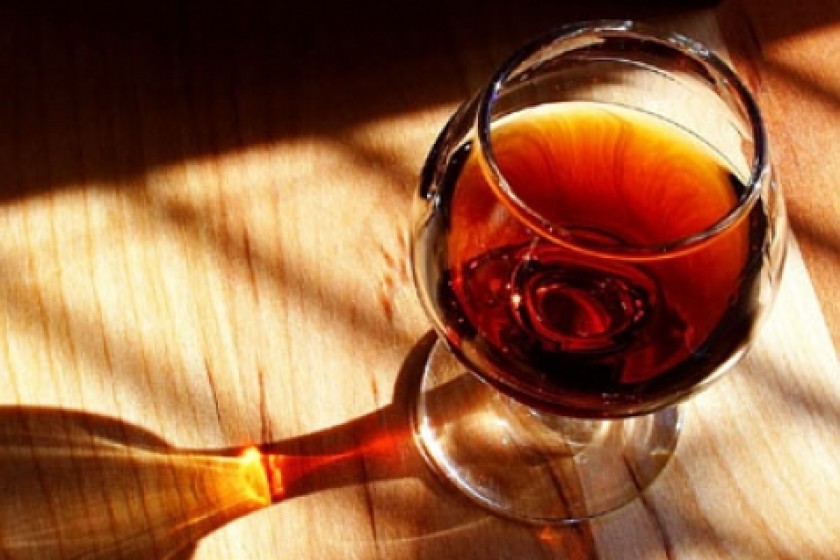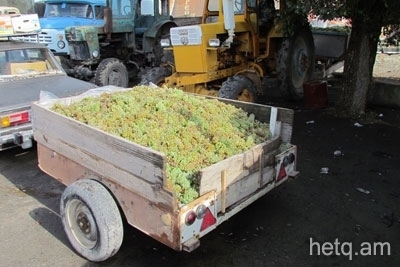
Armenia's Struggling Vintners: Government Promotes Cognac, People Prefer Vodka
Globally, 10 billion bottles of wine are sold every year. Armenia sells around 600,000 bottles per year, some in the Russian market, where 1.2 billion are sold yearly. Russia also consumes 93% of Armenian cognac.
Only 5% of the Armenian cognac sold in Russia is purchased by the wealthy elite. That’s because most of it is sold for 25-300 roubles; the price of Russian wine. There are a few Armenian cognac varieties that go for 1000 roubles.
All these numbers concern Avag Haroutyunyan, President of Armenia’s Wine Growers Union. He says that cognac production and exports have risen 10% over last year and are 30% higher than the record years back in the Soviet era.
“Armenian cognac is fairly well known throughout the world. But Armenian wine is another story,” says Haroutyunyan. He believes that wine growing in Armenia is losing out to cognac because that’s where the investment is being directed. Armenian wines also aren’t well represented on the international market.
He argues that for the past 150 years, first Russia and then the Soviet Union targeted the best winemaking technologies to Georgia and Bessarabia, while Armenia got the nod for cognac. This was due to the fact that under Seljuk and Persian rule Armenia had lost a majority of its grape gene pool – the best Armenian vineyards were in the possession of foreign conquerors.
“The Georgians had an independent state in the 17th-18th century and made sure their grapes weren’t destroyed. Thus, when Armenia was incorporated into Tsarist Russia in 1828, we had grapes that were only suited for vodka production. When European technology reached Armenia in 1860-1870, it was quite easy to produce cognac from the grape alcohol. That’s exactly what happened,” says Haroutyunyan. Armenia led Tsarist Russia in terms of cognac production.
Armenians have turned their back on wine, preferring vodka
The consumption of wine in Armenia has drooped in the last three years after steadily rising since 2003. Consumption hit a peak in 2010 at 4.2 million liters. Ten years before, the number was 3 million. Consumption today averages 3.5 million liters. 3. 6 million liters of locally produced wine was consumed in 2012. During the past twelve years, foreign wine imports have increased tenfold.
In terms of per capita consumption, the figure is one liter for Armenia. In Europe it’s fifty liters.
 “What Armenia needs is a new culture of wine appreciation. Armenians have traditionally turned away from drinking wine and that’s a dangerous trend. Wine, especially red wine, has proven health benefits. Wine is akin to medicine and is a cultural pastime in much of the world. Numerous studies have shown that men should drink 400 grams of dry red wine daily. The figure for women is a minimum of 200 grams,” Avag Haroutyunyan says.
“What Armenia needs is a new culture of wine appreciation. Armenians have traditionally turned away from drinking wine and that’s a dangerous trend. Wine, especially red wine, has proven health benefits. Wine is akin to medicine and is a cultural pastime in much of the world. Numerous studies have shown that men should drink 400 grams of dry red wine daily. The figure for women is a minimum of 200 grams,” Avag Haroutyunyan says.
The vintner says that the drop in Armenian wine consumption can be linked to emigration and the fact the puzzling trait of Armenians to appreciate foreign goods over local products.
“Today in Armenia there are three or four companies that have reached a high level in terms of quality. Armenian wines that today are priced at 2,000 – 3,000 AMD are just as good qualitatively as wines in the 1-1.5 Euro range sold overseas but are priced at 4,000 – 5,000 AMD when imported to Armenia,” Haroutyunyan says. The wine expert adds that only 10% of the wines sold on the Armenian market are of reputable quality.
Haroutyunyan believes it’s a good thing that Armenians are drinking less vodka. The record year for vodka consumption in Armenia during the past twelve years was in 2005 when 16 million liters of domestic vodka was sold. A bit less than that was also imported.
When you add the consumption of domestic and imported vodkas, the per capita figure for Armenia was in the top three globally, along with Russia and Moldova.
Vodka consumption started to drop in 2007, but rose again with the onset of the economic crisis of 2009-2009. It’s been falling steadily since 2010. This is true for domestically produced vodka and the cheaper imports. Sales of expensive vodkas have remained unchanged.
“We drink vodka due to a lack of state policy. We aren’t a nation of wine drinkers,” argues Haroutyunyan. He blames wine growers for lagging in terms of advertising Armenian wines both locally and internationally.
Haroutyunyan voices a ray of hope and says that Armenian wine growers have bandied together and have convinced the government to draft an extensive project to promote domestic wine production and exports.
Two new programs to promote Armenia wines
It’s a 120 million AMD public relations project planned for 2013-2015. Armenian wines will get greater exposure at international exhibitions and advertising to improve the image of Armenian wines domestically will take place.
On January 25, representatives of the CBI (Centre for the Promotion of Imports from Developing Countries, an Agency of the Netherlands Ministry of Foreign Affairs) met with the largest wine growers here in Armenia.
The plan is for the CBI to select ten domestic growers who will be allocated 10-15,000 Euros each to promote their product in the European market. Haroutyunyan says that Georgian wines are well known internationally due to the investment and professional advice provided by such foreign institutions.
“99% of the success in wine growing comes directly from the grape variety. All the rest, the equipment, technology, advertising, is just supplemental. It’s the grape itself that’s key, the history of the land. Producing quality wine is a very long-term process. It takes a minimum of 100-200 years to perfect,” says Haroutyunyan.
Armenian indigenous grape varieties decimated
He says that Armenia once had a large gene pool of numerous grape varieties; a fact that allowed scientists some 100 years ago to claim that the grape is native to the Armenian Highlands. Globally, there are 6-7,000 varieties of grapes and 600 are to be found in the Armenian Highlands. Traces of Urartian and pre-Urartian wine making culture have been found in the vicinity of Lake Van. For millennia, Armenian villagers have been cultivating grapes, sorting out the best varieties out of the thousands that existed.
 “We’ve ended up in a funny situation. When people ask how many grape varieties we have, we can only count one or two. In other words, a constant policy of destroying these grape varieties has been going on,” Haroutyunyan notes.
“We’ve ended up in a funny situation. When people ask how many grape varieties we have, we can only count one or two. In other words, a constant policy of destroying these grape varieties has been going on,” Haroutyunyan notes.
He says that currently there are 1,200 grape varieties in western Armenia and that the Turks still haven’t gotten around to changing the Armenian names of some 300. There are some 140 types of wine grapes in Azerbaijan that were introduced by Armenians. The reason is that until 1930 in Turkey and 1918 in Tsarist Russia, Muslims were not allowed to grow wine grapes. He claims that this came about when Islam first spread to the region in the 8th century AD.
During the Soviet era, new grape varieties were selected for Armenia that were supposed to reflect Soviet policy. They were designed to be of poor quality but provide bumper harvests. After the collapse of the Soviet Union, the vineyards of both the old and new varieties fell into disuse.
“We had 600 indigenous varieties of grape. Today, we don’t know what we have left of those 600. Perhaps a mere 100-120 have been preserved. We don’t understand the language of those 120. Now, we are only working with the Areni and Kakheti red grapes and 3-4 whites. What we have to do is select 5-10 of the best indigenous varieties and work with them, to cultivate them, in order to show the world our uniqueness. These varieties can only be found in Armenia. Today, we have serious competition from Georgia, Turkey and Azerbaijan. They are claiming those varieties for themselves,” says Haroutyunyan
The vintner believes that Armenia is travelling down a dangerous road by importing grape varieties from aboard and growing them. “This approach spells doom for Armenia,” Haroutyunyan says.
The old vineyards in Armenia are falling prey to the phylloxera and other pest related blights. 99% of the vineyards in Armenian belong to local villagers who don’t have the resources to restore them. The youngest vineyards were planted in the 1970s and in ten years they’ll disappear.
“When people mention Areni they believe it’s a blend of 10-15 varieties. In fact, there are only 100 or 200 hectares of the Areni grape in cultivation. There are plans to increase the acreage of vineyards by another 400 hectares. But what grape varieties will be planted remains a mystery,” says Haroutyunyan.
 Videos
Videos Photos
Photos
Comments (6)
Write a comment